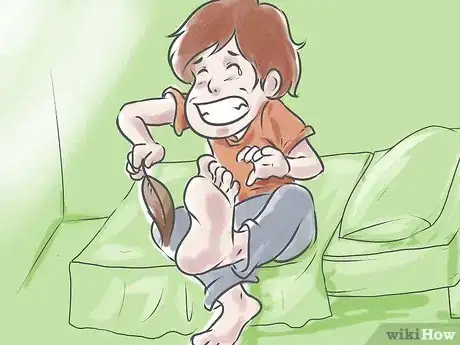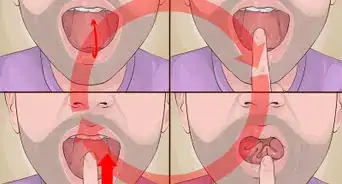X
wikiHow is a “wiki,” similar to Wikipedia, which means that many of our articles are co-written by multiple authors. To create this article, 30 people, some anonymous, worked to edit and improve it over time.
This article has been viewed 221,800 times.
Learn more...
Tickling yourself is nearly impossible, because your cerebellum (at the back of your brain) governs your movement and can predict when you're about to tickle yourself. You can, however, simulate a light tickle (called knismesis) rather than the full-on laughter-inducing heavy tickle (the gargalesis).[1]
Steps
-
1Tickle the roof of your mouth with your tongue. Lightly rotate your tongue in a circle on the roof of your mouth to create a tickling sensation. No one is entirely sure why this method works, since the areas of our brain that process sensation are less active when self-tickling.[2]
-
2Use a feather or other light object. You'll need an object that you can lightly run across a ticklish surface like the bottom of your foot, or your neck. This still won't feel like you're being tickled in as intense of a manner as when someone else tickles you, since you can't trick your brain!
- Light touch stimulates the somatosensory cortex which is responsible for analyzing touch, and the anterior cingulate cortex which deals with pleasant feelings. Together these two ares of the brain govern tickling, but only when it is a light touch. As most people already know if tickling is too hard it gets painful![3]
- You could also try brushing the soles of your feet with a bristly hairbrush.
- You can make a tickling device by taking a stick and gluing long feathers onto it. You can then use this device to tickle yourself.
- If you use too much pressure, it won't work. Make sure you're using the object very lightly.
Advertisement -
3Move your fingers in a circular motion on your skin. This doesn't always work, but some people report a mildly ticklish sensation when they barely touch their skin with their fingertips and move them around in a circular motion.
- The best places for this are the inside of your elbow, your neck, or the back of your knee.
Advertisement
Method 1
Method 1 of 1:
Part Two: Avoiding Common Misconceptions
-
1Don't tickle yourself by putting something in your ear. Not only is it a very bad idea to start putting things in your ear, as you might damage an eardrum, this also doesn't work. Your ear is no more able to be tickled than the rest of your body.
-
2Don't tickle yourself by pretending your hand doesn't belong to you. Scientists have done experiments where they tried to trick a person's brain into believing that a plastic hand on a table in front of them was their hand. Even when the person's brain was under the illusion that the plastic hand was theirs, they still couldn't tickle themselves.[4]
- However, often people with schizophrenia can tickle themselves, possibly because their brains have difficulty predicting the sensory actions of their own movements.
-
3Don't rub your nails on your sides. The problem with this idea is that it operates under the notion that the reason you can't tickle yourself is because of your brain registering that it's your own fingers doing the tickling, so if you use your fingernails, your fingers won't register the sensation.
- This is wrong because it isn't the sensation, it's the brain already knowing what is about to happen. Tickling has to do with surprise and we can't surprise our own brains.
Advertisement
Community Q&A
-
QuestionIs it possible to be ticklish on your face?
 Community AnswerIt is more common to be ticklish on your neck and, in some cases, ears. However, very light touches anywhere on your body can produce a tickling sensation.
Community AnswerIt is more common to be ticklish on your neck and, in some cases, ears. However, very light touches anywhere on your body can produce a tickling sensation. -
QuestionCan I tickle animals?
 Community AnswerNo, you should not tickle animals. However, you can pet them if they are friendly.
Community AnswerNo, you should not tickle animals. However, you can pet them if they are friendly. -
QuestionIs it possible to tickle myself?
 Community AnswerYes, it is.
Community AnswerYes, it is.
Advertisement
Warnings
- If these don't work on you, just remember that it is incredibly difficult to fool your brain or surprise it by yourself (which is how tickling works).⧼thumbs_response⧽
- Be careful when handling sharp or pointy objects.⧼thumbs_response⧽
Advertisement
References
- ↑ The Psychology of Tickling, Laughing, and the Comic G. Stanley Hall and Arthur Alliń. The American Journal of Psychology , Vol. 9, No. 1 (Oct., 1897), pp. 1-41
- ↑ http://www.scientificamerican.com/article/tit-for-tat-delusions/
- ↑ http://scienceline.ucsb.edu/getkey.php?key=1172
- ↑ http://www.npr.org/templates/story/story.php?storyId=248041246
About This Article
Advertisement




























































